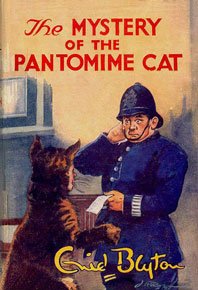
The Mystery of the Pantomime Cat

Book Details...
First edition: 1949
Publisher: Methuen
Illustrator: Joseph Abbey
Category: Five Find-Outers
Genre: Mystery/Adventure
Type: Novels/Novelettes
Publisher: Methuen
Illustrator: Joseph Abbey
Category: Five Find-Outers
Genre: Mystery/Adventure
Type: Novels/Novelettes
On This Page...
Reprints
1. 1963 Armada, illustrations and cover by Charles Stewart
2. 1966 Dragon, illustrations by Mary Gernat, cover by Peter Archer
3. 1970 Methuen, illustrations by Mary Gernat, cover by Peter Archer
4. 1973 Dragon, illustrations by Mary Gernat, cover by Paul Wright
5. 1979 Methuen, illustrations by Mary Gernat, cover by Reginald Gray
6. 1983 Dragon, illustrations by Mary Gernat, cover Bruno Elettori
7. 1987 Dragon, illustrations by Mary Gernat, cover Mick Austin
8. 1990 Dean, illustrations by Mary Gernat, cover by Liz Roberts
9. 1991 Armada, illustrations by Rodney Sutton, cover uncredited
10. 1996 Mammoth, illustrations by Mary Gernat, cover by Button Design Co.
11. 1997 Dean, illustrations by Mary Gernat, cover by Button Design Co.
12. 2003 Egmont, not illustrated, cover by Jason Ford
13. 2004 Dean, not illustrated, cover by Button Design Co.
14. 2010 Egmont, not illustrated, cover by Martin Usborne and Shutterstock
15. 2014 Egmont, not illustrated, cover by Timothy Banks
16. 2016 Hodder, not illustrated, cover by Timothy Banks
17. 2021 Hodder, not illustrated, cover by Timothy Banks
2. 1966 Dragon, illustrations by Mary Gernat, cover by Peter Archer
3. 1970 Methuen, illustrations by Mary Gernat, cover by Peter Archer
4. 1973 Dragon, illustrations by Mary Gernat, cover by Paul Wright
5. 1979 Methuen, illustrations by Mary Gernat, cover by Reginald Gray
6. 1983 Dragon, illustrations by Mary Gernat, cover Bruno Elettori
7. 1987 Dragon, illustrations by Mary Gernat, cover Mick Austin
8. 1990 Dean, illustrations by Mary Gernat, cover by Liz Roberts
9. 1991 Armada, illustrations by Rodney Sutton, cover uncredited
10. 1996 Mammoth, illustrations by Mary Gernat, cover by Button Design Co.
11. 1997 Dean, illustrations by Mary Gernat, cover by Button Design Co.
12. 2003 Egmont, not illustrated, cover by Jason Ford
13. 2004 Dean, not illustrated, cover by Button Design Co.
14. 2010 Egmont, not illustrated, cover by Martin Usborne and Shutterstock
15. 2014 Egmont, not illustrated, cover by Timothy Banks
16. 2016 Hodder, not illustrated, cover by Timothy Banks
17. 2021 Hodder, not illustrated, cover by Timothy Banks

Wraparound dustwrapper from the 1st edition, illustrated by Joseph Abbey

1st German edition published by Erika Klopp Verlag in 1955,
illustrated by Walter Born with the title Mystery of the Cup of Tea
German: Geheimnis um eine Tasse Tee
French: Le Mystère du Chat Botté
Dutch: De Vijf Detectives – De verdachte poes
Spanish: Misterio del Gato Comediante
Portuguese: O Mistério do Gato Cómico
Swedish: Mysteriet med teaterkatten
Danish: Mysteriet om teaterkatten
Finnish: Teatterkissan salaisuus
Icelandic: Dularfulla leikhúsránið
Czech: Tajemstvi Kocouriho Muze
Brief Summary by Julie Heginbotham: Mr Goon is off on holiday and P.C. Pippin is his replacement until he returns. The Find-Outers decide to have a little fun with this new P.C. and so make up a little mystery for him. But the clues they leave put P.C. Pippin right at the forefront of a real mystery, when he finds the manager of the Little Theatre unconscious and slumped over his desk, and the safe open and empty. The Find-Outers are soon on the case, interviewing suspects and looking for clues, but sadly for them, P.C. Goon returns to Peterswood and takes over the case from Pippin, and he is convinced that the Pantomime Cat is guilty of the crime. The Find-Outers have other ideas and set about trying to solve this mystery as quickly as possible.
Full Reviews (These may contain spoilers):
Imran Patel's Review
It makes a welcome change for the reader to puzzle his brains over a whodunnit after reading a great adventure — and that is just what we welcome after reading The Mystery of the Hidden House, more an adventure novel than a detective one. (That's why Mystery fans may not take to it.) In The Mystery of the Pantomime Cat however, Blyton presents us with a truly puzzling mystery — which some have said to be the best of the series; and some have said to be the most juvenile of the series. What is this book's high point? And when does it falter a little? Well, we shall see!
We begin waiting for Fatty (and Pip and Bets). Surprise, surprise; Mr. Goon happens to be there too, waiting for a person. And who will the person be? Another policeman with the name of Pippin! The Find-Outers like the look of him, with Bets saying, "I like how his ears stick out". Mr. Goon (who happens to be going for a holiday) of course, wastes no time in telling Pippin what he thinks of the Five, and Pippin is puzzled, saying he liked the look of them. As Enid says, that was not the ideal remark to make to Goon! You have got Mr. Goon's anger upon you, Pippin! Anyway, the scene has been set.
The Find-Outers have nothing to do, so they make up a false mystery complete with false clues (Hidden House, anyone?) for Pippin to follow and be led on a wild goose chase. Surprisingly, no one thinks of the previous mystery where they did the same thing. Disguises. Notes. False clues. This has all been repeated of course, but it does make for some entertaining reading. Pippin is completely taken in and, naturally, very excited at being confronted with his first "case". What follows is Fatty (using an old trick) disguising himself as a lot of red-headed boys and men, and Pippin being taken in, until he remembers the warning from Goon (why didn't he remember earlier? I suppose just because he was a bit too excited: a typical young new policeman.) Needless to say, the next red-headed person Pippin comes across is not Fatty (it's the vicar's brother!) and Pippin in classic Goon style tears the vicar's brother's hair out as he mistakes it for a wig. I almost expected a Goon-like "Gah!" from Pippin when he finds out the truth, but then, Pippin is not Goon!
On with the story. Pippin goes to Little Theatre, following instructions on a note, and picks up the clues. The clues are: a handkerchief with Z sewed on; a cigarette with the "Players" brand and a navy coat button. Pippin sees the pantomime cat (which was also seen by the boys when they came earlier to drop the clues) and then, curiously, he hears some groans. The noise is coming from behind him! When he goes to investigate, he finds the manager drugged and robbed! The Real Mystery has begun!
The Find-Outers envy Pippin for being in the right place at the right time, but what they don't realize is that they are indirectly responsible for that! When Fatty goes to Pippin's house to ask questions, he gets a surprise. Mr Goon has returned! And what a return! What could be a better, more classical return for Mr Goon than to begin to shout at someone for no reason at all, eh? Well, he just does that! And there's a great scene with Mr Goon — Fatty — Pippin — and Buster! Poor Buster is beaten by Mr. Goon with a poker (Goon a policeman? Gah! If I were Fatty, I'd report him for that!) And Pippin in a nice way comes to his rescue. Then it all boils up. Anyway, Pippin gives Fatty all the information he needs. The Find-Outers are on the case!
What follows is a very enjoyable mid-section, which I found, by far, to be the best section of the novel. There are loads of suspects; but they all have unshakeable alibis! Very puzzling, eh? Goon is convinced that Boysie is the culprit; he is the pantomime cat and the pantomime cat was seen by the manager (and the five and Pippin!) to be the only person left in the theatre. The manager swears that he saw the pantomime cat (Boysie) giving him tea, but Boysie swears he didn't! Whom should we believe?
At this time I started having a serious doubt about the plot. Could — it — be...no, I'll come back to that later.
The Find-Outers can't possibly believe that Boysie committed the crime, simply because he couldn't. No, not because he is "very nice", but because he is like a child. However, Zoe is crossed out just because she is "nice". Hmm!
Of course, the false clues the Find-Outers laid do play an important (and irritating) part in the story, and are not needed (except for Goon!) needless to say, the whole thing is frankly unnecessary, but then, it helps Goon become stronger in his suspicions. If the false clues hadn't been there, Goon's accusation of Zoe would fall flat; and the clues make the story more interesting!
Anyway, enough of nit-picking. We are now at the best section of the book. The Find-Outers check the suspects' alibis and find them, surprisingly or unsurprisingly, to be true. As the last suspect (hmm!) is crossed out, and the Find-Outers admit defeat, there comes a surprise. I won't tell you what it is exactly, but it's accurate to say that Goon is horrible in this book, and does a truly horrible thing.
The Find-Outers are losing the race against time, until, as usual, Bets' remarks come to the fore. Says she, "It almost makes you think it must have been somebody else in Boysie's skin." Gah! You got it now?! [Now not necessarily to Bets, but the whole Find-Outers.] Call yourself a bunch of detectives?! Bah! Even queerer is the response to this statement: "The others laughed scornfully. 'Silly!' said Pip, and Bets went red." Huh? What's all that? Oh come on, Fatty and all, surely it struck you before that anyone could have been in the suit! Yes, Boysie was the pantomime cat, but then, was it impossible for someone else to take his place? As for who was in the skin, I'm not sure at this point...anyway, Pippin? Did that not strike you? If it didn't, however did you become a policeman?! Oh come on...
I didn't realize that everyone could be so stupid. Or is it that there was another twist hidden in the book and we never saw it?!
But let's get on. Fatty explains what happened (I still can't get over the fact that he didn't get this before!) that evening, and it is almost like Agatha Christie, with the great use of italics, with the only difference to Christie being the tense: Fatty explains it in the past tense; Poirot does it in the present, and I feel that I like the latter more...anyway, as Fatty says: "Who could have been inside the suit?" Who indeed, eh? Did we miss something?
Groan. We didn't.
Now here we have some extremely crucial information given to us by Blyton. If this information hadn't been given, we couldn't have known the culprit. In fact, we couldn't have solved the mystery. Then...?
As soon as Blyton's information is given to us, the whole mystery becomes as plain as a pikestaff. Maybe that's why she didn't give it earlier...! Maybe, or maybe not! I'm sure that such a great mystery writer as Blyton could twist it a little bit more, to conceal the (obvious) conclusion. But the trouble was that she didn't.
I won't give away any more details, but it all strikes me as lazy and not being properly planned out. Blyton did have a great plan for this book (a whodunnit as Fatty says) and she went on with it, but at the end she does falter a lot. The result? A "could-have-been".
In fact, had this been properly planned, it would have probably been the best book of the series, even better than Invisible Thief, the next title, for while that book too is a whodunnit and the best book of the series in my opinion, it has many burglaries, not a single one which creates atmosphere. But while Blyton properly planned that one out; this one she didn't.
It is a pity. It could all have been better. The "Innocent Bets" statement and the information (without which, sadly, it makes it impossible for us to know the culprit) could have been given earlier, but a twist (a better one) could have been given so as to conceal the obvious conclusion, which in the end could have been given dramatically. Err, but that did not happen. Sadly, Enid let down this great plan for a whodunnit (my favourite genre for the series).
All in all, a book that is the sole (not) "could-have-been" of the series. The Mystery of the Strange Bundle also falls in this category, but that book was a little better than this (even though that wasn't an ordinary mystery) for other reasons. Sigh.
My rating: a weak 8/10. But then, it did get 8, and my conclusion is: it is good one, but not properly planned and falters at the end.
On to The Mystery of the Invisible Thief, my favourite book of the great Mystery series!
Robert Houghton's Review
On to the seventh book — The Mystery of the Pantomime Cat. As mentioned in the first section, this is easily the best story of the series. It has several strong characters, several very good clues, and is the most mysterious and exciting of the fifteen books. It also deals less with comic asides and more with plot and is all the stronger for it. Like the Famous Five books, the Find¬-Outers series also seems to come in sections. Books 1-6 fall into section one, in which the characters and situations seem, maybe, more juvenile in their approach (with maybe a couple of exceptions). These books are more like the 'holiday adventure' type, which Enid was writing during the war. From book seven the emphasis seems to change. As the children grow older, so the plots of the books mature and become more complicated. The clues are better laid down and the suspects are more numerous. At the same time, the outcome is often more surprising and takes more working out than the earlier books.
Once again, the mystery starts with the children deciding to set up a false set of clues, this time to trick Goon's stand-in while he's on holiday, P.C. Pippin. Pippin is a good character, nowhere near as over the top as Goon. He is rather a likeable character, and it's easy to feel sorry for him when the children lead him such a merry dance. But soon, they realise that Pippin is actually an ally and not an enemy. Goon's part is played down quite considerably in this instance, and perhaps this is the reason that there is more plot and less comedy. It is the nearest Enid ever got to a 'true' whodunnit.
The clues are laid down well, and the suspects (of which there are plenty) are all well-rounded individuals, almost all of them with a motive for wanting to rob the manager of the theatre. However, Pippin has actually seen the crime take place, (due to the children's false clues) and he has seen the pantomime cat just prior to the robbery. When he discovers the safe has been opened and the manager drugged, he puts two and two together...or rather, Goon does. As in The Mystery of the Disappearing Cat, an innocent (this time 'Boysie' the simple fellow who spends much of his time in his cat suit) is accused by Goon, and 'terrorised' by the policeman into a confession. Once again, the children befriend the victim and declare that they will clear his name. Further complications ensue when some of the false clues match up with suspects, such as the 'Z' Daisy has sewn on a handkerchief and Zoe Markham, Boysie's friend, who ends up being marked by Goon as an accomplice.
As in many of the stories, it is Bets who helps to solve the crime. By uttering another innocent statement, 'It almost makes you think it must have been someone else in Boysie's skin', she clicks Fatty's brains into action. Of course! It was someone else in the cat skin. Then comes the best twist of the whole series; totally unexpected to most readers. The real culprit is one of the suspects already questioned; a female impersonator who got his twin sister to perform in his place, while he went off a-robbing! Okay, so it sounds far-fetched, but it actually works very well indeed.
To top it all, Goon gets his comeuppance in front of the Inspector. In a delicious moment, the Inspector tears Goon's so called 'confession' from Boysie into pieces and hands it to the fat policeman. "There's a fire behind you, Goon." he says, "Put this in, will you?". It is a marvellous moment, gloriously understated, and summed up with Enid's words; 'if ever cruelty and stupidity and conceit were punished well and truly, then they were punished now, in the person of Goon.' These illustrations are hidden by default to ensure faster browsing. Loading the illustrations is recommended for high-speed internet users only.








